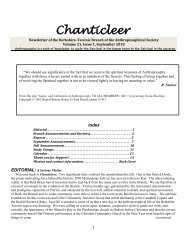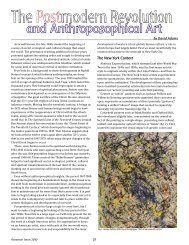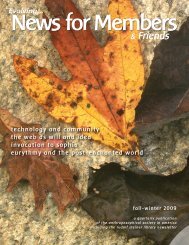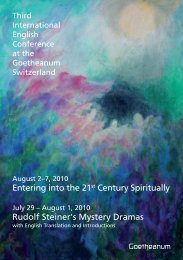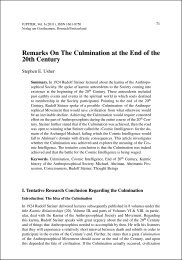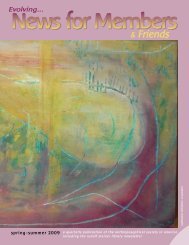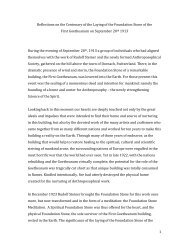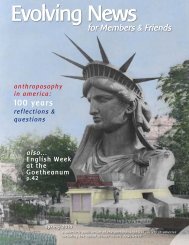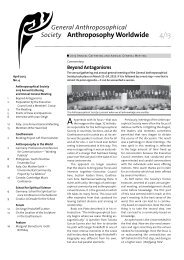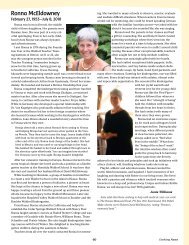Rudolf Steiner's Vision for the Future - Anthroposophical Society in ...
Rudolf Steiner's Vision for the Future - Anthroposophical Society in ...
Rudolf Steiner's Vision for the Future - Anthroposophical Society in ...
You also want an ePaper? Increase the reach of your titles
YUMPU automatically turns print PDFs into web optimized ePapers that Google loves.
The Search <strong>for</strong> Humanity <strong>in</strong> Contemporary Art<br />
Olafur Eliason – Your Uncerta<strong>in</strong> Shadow, 2010, Berl<strong>in</strong><br />
Mar<strong>in</strong>a Abramovic – Balkan Baroque, 1967, per<strong>for</strong>mance at Venice<br />
Biennale, clean<strong>in</strong>g 1500 beef bones<br />
of <strong>in</strong>stallation art, I po<strong>in</strong>ted out several of his key predictions<br />
<strong>for</strong> <strong>the</strong> future of <strong>the</strong> visual arts that seemed to apply to postmodern<br />
art:<br />
1. The true work of art is <strong>the</strong> <strong>in</strong>visible experience <strong>in</strong><br />
<strong>the</strong> soul of <strong>the</strong> viewer, not <strong>the</strong> outer object.<br />
2. The visual arts must become more like <strong>the</strong><br />
musical/per<strong>for</strong>m<strong>in</strong>g arts (and vice versa).<br />
3. More movement, mobility, and metamorphosis<br />
must be brought <strong>in</strong>to <strong>the</strong> static visual arts.<br />
4. More (ahrimanic) ugl<strong>in</strong>ess and less illusory<br />
(luciferic) beauty must enter art.<br />
5. Art must overcome <strong>the</strong> use of art exhibitions.<br />
6. Art should not be so elitist, but ra<strong>the</strong>r more<br />
<strong>in</strong>tegrated <strong>in</strong>to <strong>the</strong> general life of society and<br />
civilization.<br />
Is anthroposophical visual art mov<strong>in</strong>g toward this future<br />
or is it primarily repeat<strong>in</strong>g <strong>the</strong> (modernist) past?<br />
At this po<strong>in</strong>t my lecture morphed <strong>in</strong>to a conclud<strong>in</strong>g<br />
ten-m<strong>in</strong>ute piece of per<strong>for</strong>mance art (titled Because Postmodernism<br />
Is) <strong>in</strong>volv<strong>in</strong>g speak<strong>in</strong>g, gestures, chant<strong>in</strong>g, a dream<br />
26 • be<strong>in</strong>g human<br />
image, slides of artworks by Joseph Beuys, Robert Morris,<br />
and Bill Viola, musical and rhythmic accompaniment on<br />
Manfred Bleffert <strong>in</strong>struments, and a bit of m<strong>in</strong>or choreography<br />
with my assistant Laura Summer.<br />
Discussion<br />
After this, <strong>the</strong> conference broke up <strong>in</strong>to four smaller discussion<br />
groups. I was part of <strong>the</strong> group guided by Michael<br />
Howard, <strong>in</strong> which we conversed about see<strong>in</strong>g <strong>in</strong> art <strong>the</strong> signs<br />
today of humanity cross<strong>in</strong>g <strong>the</strong> threshold unconsciously and<br />
how <strong>the</strong> old visual art tradition has been broken down over<br />
<strong>the</strong> past hundred years so that it is no longer shock<strong>in</strong>g nor<br />
do we any longer have to struggle with that, only to work<br />
with it. We considered <strong>the</strong> contrast of collective identity versus<br />
<strong>in</strong>dividual identity, where <strong>the</strong> latter is what is necessary<br />
both <strong>for</strong> <strong>the</strong> experience of truth and <strong>for</strong> <strong>the</strong> expression of empathy<br />
and compassion. Do <strong>the</strong> anthroposophical convictions<br />
that unite us also tend to prevent us from really meet<strong>in</strong>g o<strong>the</strong>r<br />
people, also with our art? It helps to know all human be<strong>in</strong>gs<br />
as striv<strong>in</strong>g persons <strong>in</strong> <strong>the</strong>ir own way. Yet how do we build a<br />
new social life today when every <strong>in</strong>dividual is like a “chief”<br />
or “pharaoh,” when <strong>the</strong>re is so much emphasis on freedom<br />
but so little on spirituality? While modernism was about revolutions,<br />
how can postmodernism or anthroposophy come<br />
to terms with evolution?<br />
The Art of Spirit Self<br />
On Sunday morn<strong>in</strong>g Michael Howard presented <strong>the</strong><br />
f<strong>in</strong>al lecture, titled “The Art of Spirit Self.” He stated that<br />
what Ste<strong>in</strong>er said about future human evolution can be very<br />
<strong>in</strong>spir<strong>in</strong>g and even practical, although we may have to adjust<br />
our expectations about how much of <strong>the</strong> distant future (e.g.,<br />
sixth epoch) can actually be realized now ra<strong>the</strong>r than <strong>in</strong> future<br />
<strong>in</strong>carnations. While human life is def<strong>in</strong>ed by polarities (<strong>in</strong>clud<strong>in</strong>g<br />
<strong>the</strong> contrasts of modernism and postmodernism), it<br />
is more challeng<strong>in</strong>g and more essentially human to live with<br />
<strong>the</strong> tension <strong>in</strong> between (or encompass<strong>in</strong>g) both sides of such<br />
polarities as matter and spirit, <strong>in</strong>dividual and community,<br />
freedom and responsibility.<br />
While <strong>in</strong> art we typically say modernism has existed<br />
about a hundred years and postmodernism about 50 years,<br />
we can also trace <strong>the</strong> beg<strong>in</strong>n<strong>in</strong>gs of modernism (and <strong>the</strong>



